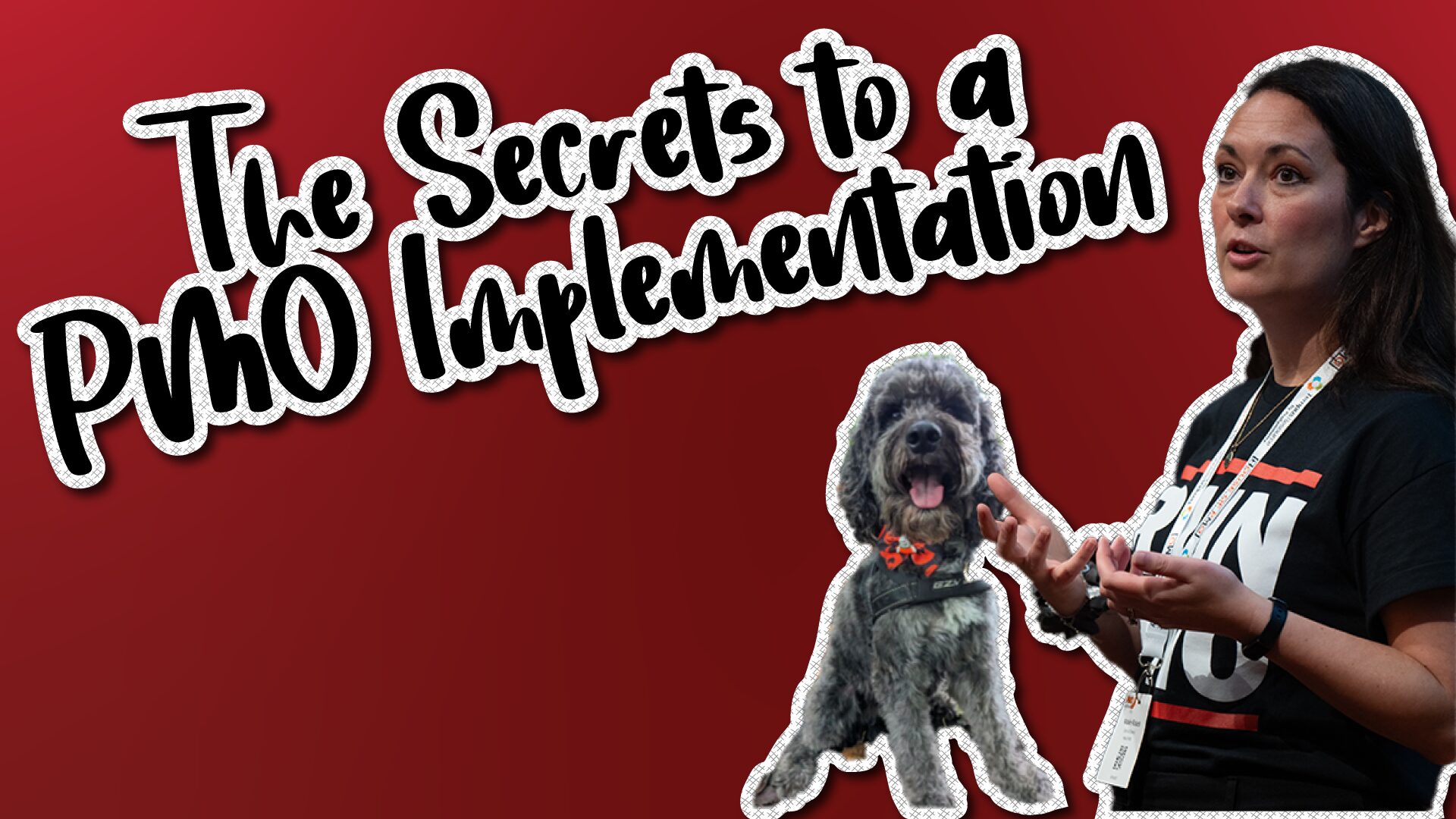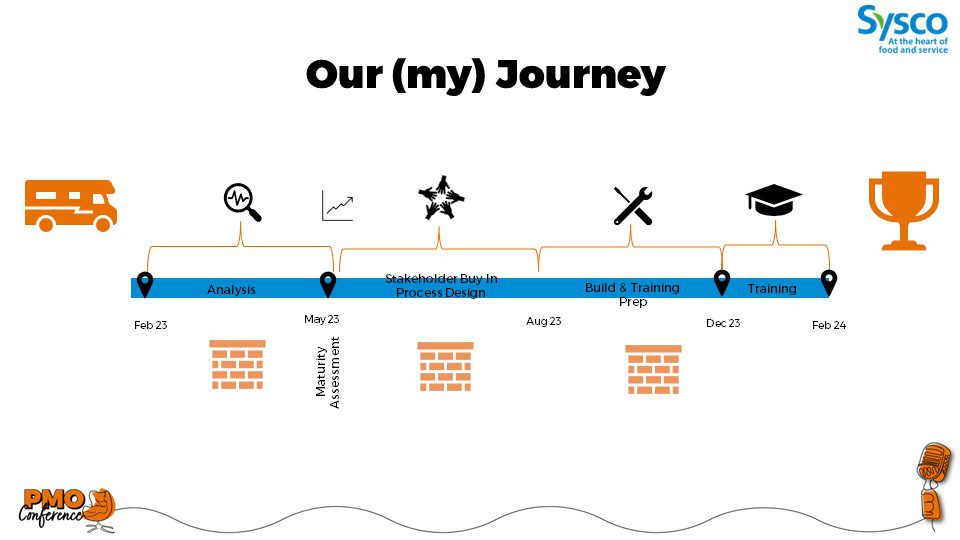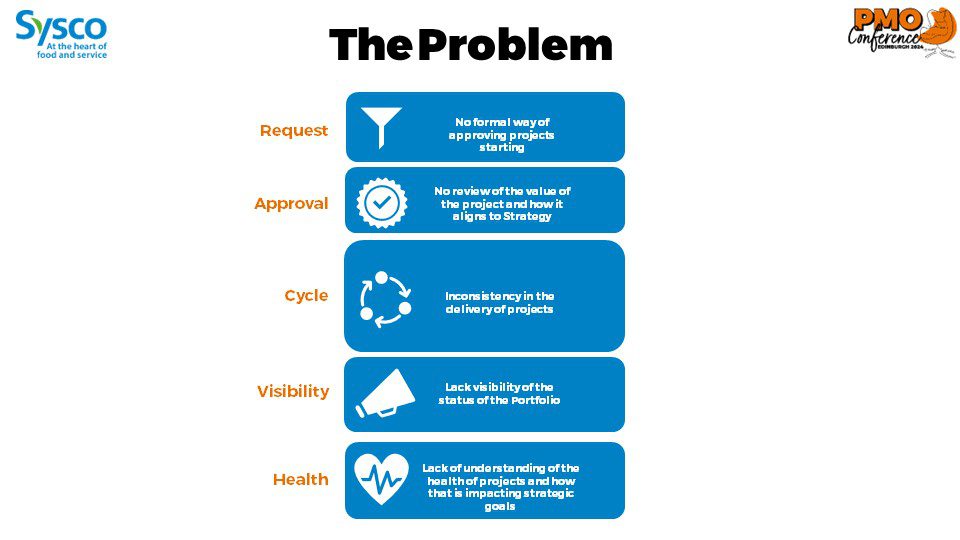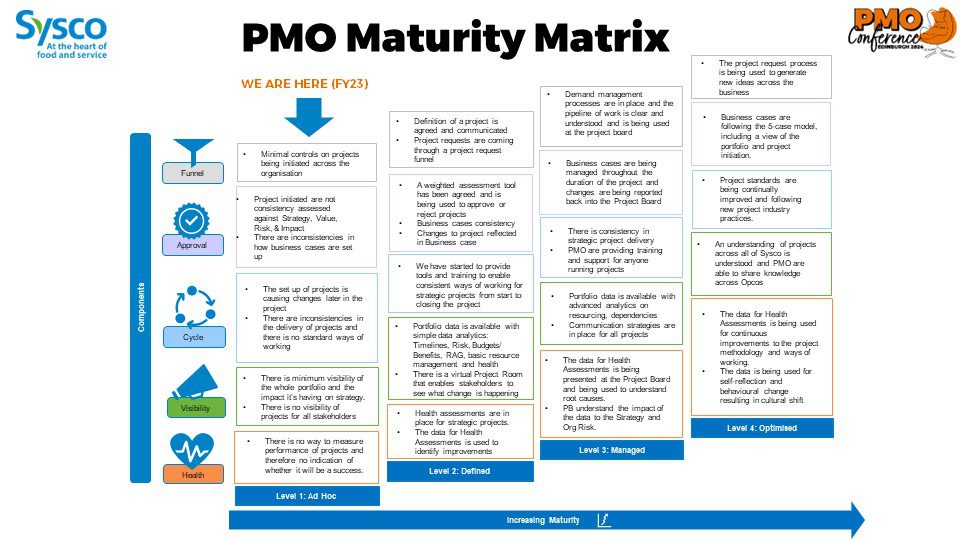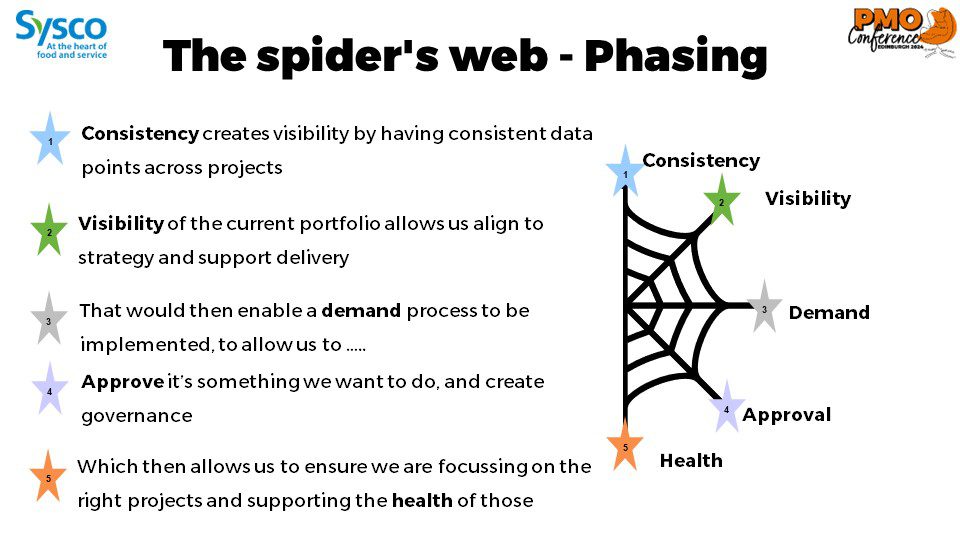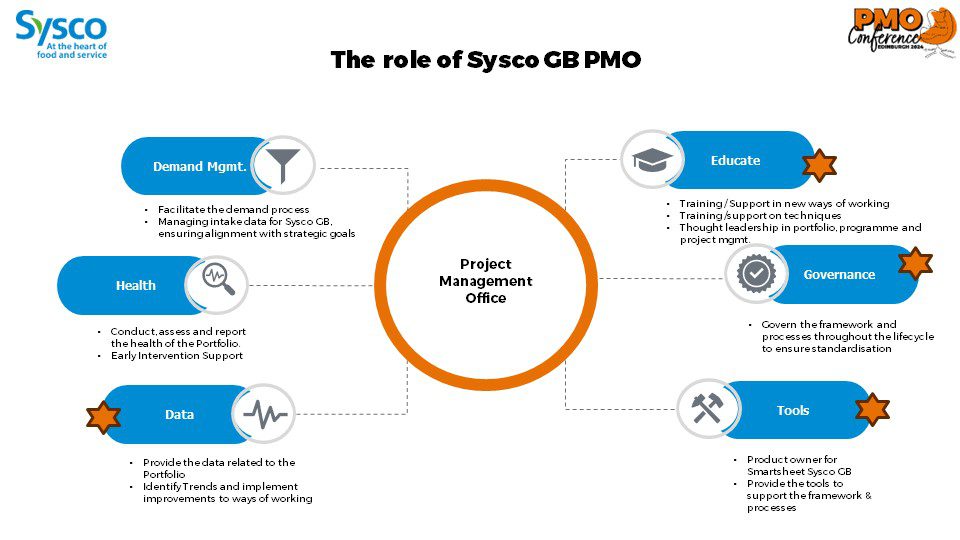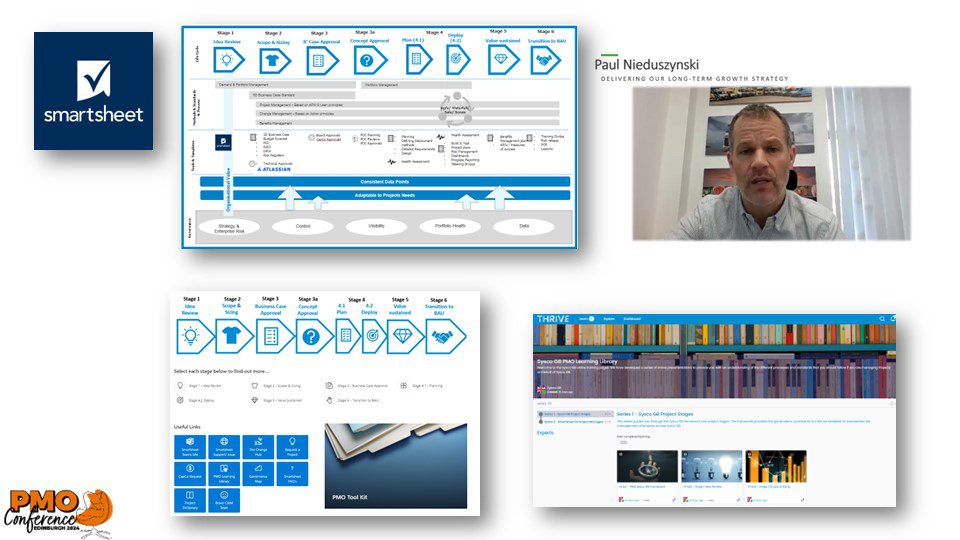Watch back all our PMO Conference sessions
One Woman and Her Dog: The Secrets to a PMO Implementation
Sysco GB’s Head of PMO invites you to join her journey as one woman implementing a PMO – hear about Natalie Rickard’s inspiring story from maturity assessment to implementation.
 In this session, Natalie will share her method for conducting maturity assessments and how she tailored it to fit her organisation, utilising the output to guide her next steps to make the biggest impact.
In this session, Natalie will share her method for conducting maturity assessments and how she tailored it to fit her organisation, utilising the output to guide her next steps to make the biggest impact.
Learn about her choice of bottom-up approach, prioritising project consistency before advancing to portfolio management and how she illustrated that data can be used to educate and change behaviours at all levels of the organisation.
Discover how, with the help of her dog Hendrix, Natalie fiercely protected her time, maintaining a healthy rest ethic, which was crucial in her journey as a one-person PMO.
Recorded Session
Presentation Deck
Download the DeckInsights from the Session
Sarah Hazeldine, PMO Conference Report provides her insights from the session:
As a One-Woman PMO, I was excited to attend the session “One Woman and Her Dog,” convinced I could learn from Natalie Rickards. I wasn’t disappointed.
Natalie began by engaging the audience, asking us to stand and share the PMO challenges we faced. I chose “lack of resource” (I did say I’m a one woman show?) while others selected leadership buy-in, perceived lack of value, adoption to change, lack of data and lack of consistency. It’s clear that PMOs we still face challenges but then life would be boring if we didn’t.
Natalie shared her Sysco PMO journey through four stages: Analysis, Stakeholder Buy-In and Process Design, Build and Training Prep & Training and explained how her trusted companion Hendrix helps her maintain work-life boundaries by ensuring she steps away from her desk.
Stage 1: Analysis: Natalie started with a lot of listening, meeting key stakeholders, conducting a survey and applying health assessments to current projects. Natalie explained that there were lots of distractions during this phase (and not from the dog!) where stakeholders identified their perceived needs such as a demand process, post implementation reviews and templates. But these had been tried (and failed) previously.
Natalie identified 3 major problems.
- Demand Process: Projects were approved based on funding availability without considering resource allocation.
- Lifecycle Clarity: The lifecycle wasn’t clear with Inconsistent scheduling tools (Excel, PowerPoint) and terminologies being used, with emotional RAG status applications.
- Data Deficiency: Lack of data on project numbers and statuses.
To start to overcome these problems, Natalie created a Maturity Matrix setting everything at level 1 providing a sense of urgency with the leadership.
But even with this Natalie needed to decide what was the first improvement to be tackled to move the needle the most.
To do this Natalie split the work into a series of phases: Consistency across the projects; Visibility of all the projects; Demand process (enabled by the previous phases); Approvals process; Health.
Stage 2: Stakeholder Buy-In: Natalie worked on getting everyone to understand why consistency was key and the role of the PMO
Stage 3: Process Design and Build: Natalie travelled across the company explaining the value of data in decision making, especially when one Exec didn’t want a planning phase. She created a group of allies to govern each data point, including removing the emotion out of the RAG reporting. There was a pressure to get things done quickly but it was important that things were done right.
Stage 4: Training and Implementation: The CEO got involved with the launch of the PMO creating a video introducing the new framework and toolkit. A training day for all Project Mangers was arranged during a travel ban, highlighting the important of the changes.
So, what were the results? Natalie is able to demonstrate consistency across projects with the CFO commenting that Finance were proud of the reporting. Execs are using the App that has bee created and PMs are gaining confidence.
Natalie is no longer a one woman PMO, she is sharing the process with the European Market and has a team to support her.
What did I take away? I’ve been going through a similar process and many points reflected my own experiences. BUT I need to improve my boundaries and will be looking to address this. I will also be looking at the Maturity Matrix across my service catalogue in the new year, going outside of the leadership team to check how the services are landing in the wider team.
Thanks Natalie for sharing with us your journey and all the best going forward.
Key Takeaways
Here are some of the key lessons Natalie Rickards shared in her presentation:
- Say NO & stay focused: It’s crucial to prioritise tasks that make the biggest impact on PMO maturity and learn to decline requests that don’t align with current goals. For example, while Natalie recognised the need for templates, she prioritised consistency and visibility in the initial phases, deferring template creation to a later stage. This approach helped her maintain focus on the most critical elements of PMO implementation.
- Remember what will make the biggest impact to your maturity: When facing a myriad of challenges, it’s essential to prioritise those that significantly influence PMO maturity. Natalie addressed this by creating a PMO Maturity Matrix to highlight key areas needing improvement and strategically phased her implementation to focus on consistency and visibility first, understanding that these would have the most substantial impact.
- Build your network: Engaging with stakeholders and building relationships is fundamental to successful PMO implementation. Natalie achieved this through extensive listening sessions with project managers, programme managers, sponsors, and anyone involved in projects. She also conducted pulse surveys to gather quantifiable data and qualitative feedback, ensuring everyone had a voice in the process. This approach fostered understanding and buy-in across the organisation.
- Talk, Talk, Talk – Listen, Listen, Listen – win the hearts, then minds: Effective communication is vital for securing stakeholder support and driving change. Natalie emphasises the importance of frequent and open dialogue with stakeholders to address concerns, explain the value of the PMO, and gain their buy-in. She also highlights the importance of creating a safe space for open communication and feedback.
- Data has no emotion, use it to create some! Data-driven decision-making is crucial for demonstrating PMO value and influencing executive behavior. Natalie effectively framed data to create emotional connections by linking project health to strategic goals and enterprise risks. This approach resonated with executives, leading to positive behavioral changes and PMO support.
- Set Boundaries: Natalie emphasised the importance of setting boundaries to avoid burnout and maintain a healthy work-life balance. Her dog, Hendrix, played a crucial role in enforcing a strict work schedule, ensuring she took breaks and had time to decompress. This boundary-setting allowed for better focus and decision-making, ultimately contributing to her success.
- Utilise a PPM Tool: Leveraging a PPM tool can streamline processes, improve data collection, and enhance visibility across projects. Natalie’s implementation of Smartsheet, a PPM tool, resulted in consistent data across programmes, portfolio, and projects. This enabled data-driven conversations, improved reporting, and increased executive engagement.

